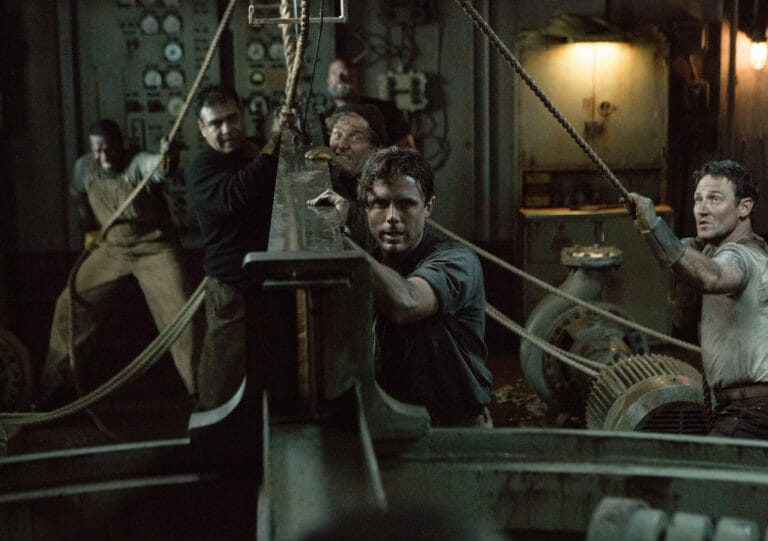Sign up for the
TSL Newsletter
and get $50 off Final Draft 12
By Nguyen Le · February 1, 2016

On Feb. 18, 1952, a ferocious nor’easter picked the oil tanker SS Pendleton to be the Titanic’s spiritual successor, splitting it in two and presenting its survivors with a next to nil chance of seeing shore again. Yet from the safety of land emerged four Coast Guardsmen who made it their mission to carry out the most daring rescue in U.S.’ maritime history. Such an incredible event begs for a riveting adaptation, something The Finest Hours sadly delivers only in fits and bursts.
Prior to heeding the call of duty, shy and rulebook-respecting Bernie Webber (Chris Pine, turning in a refreshingly understated performance) finds himself on a date with Miriam (Holliday Grainger, who is much kinder here than she was in Cinderella, at times recalling the Fay Wray/Katherine Hepburn days). Their interactions showcase director Craig Gillespie’s talent for crafting believable chemistry, which also extends to the four-man rescue team – featuring the welcome faces of Ben Foster and Kyle Gallner – as well as all those adrift on the Pendleton. The star of the film, however, is undoubtedly Casey Affleck as engineer Ray Sybert. As Sybert, Affleck exudes solid leadership and quiet confidence every time emerging as an unexpected hero amongst his crewmates.
Like the sea itself, Hours is uneven and choppy at certain points, and it’s at its worst when it’s ashore. There’s just isn’t much in the way of interesting drama to speak of back on land, which results in cliché after cliché – it’s a waste considering the film is penned by the trio behind David O. Russell’s The Fighter (the most meaty moments of which took place outside the ring). The beats are overly familiar, lifted out of a dozen similar rescue movies, and while the significance of certain moments are clear and sometimes even necessary the execution is too safe, too artificial. Even the direction seems eager to get to the ocean.
And why not, especially with Javier Aguirresarobe’s spectacular cinematography? Compared to their previous collaboration, the flawed-but-fun Fright Night remake, he and Gillespie construct their set pieces in Hours with more restraint – always serving the story and never showing off. In several instances, the sea itself plays a part in controlling how the camera moves and what it sees – an interesting technique that brings a layer of controlled chaos to the action. Even for the less boat-rocking moments, Hours is still a gorgeous picture with wintry vistas and cozy, sepia-tinted interiors that seem to have been plucked straight out paintings of the era.
Also appropriately old-fashioned is an adaptive score that is solemn on shore while ferocious at sea. Carter Burwell continues to show his flexibility with different genres including a certain panache for period pieces. Much credit should also be given to production designer Michael Corenblith (also no stranger to recreating old days as seen in Frost/Nixon or Saving Mr. Banks), especially for his detailed work on the Pendleton’s engine room with all the grime and rust.
In his second contribution to Disney’s true stories department after Million Dollar Arm, Craig Gillespie again approaches the material with interest and respect, and the result is predictably grand in scope. Much like his earlier India-centric drama, Hours serve up few surprises but offers some genuine suspense, so long as the film doesn’t drift too close to show.